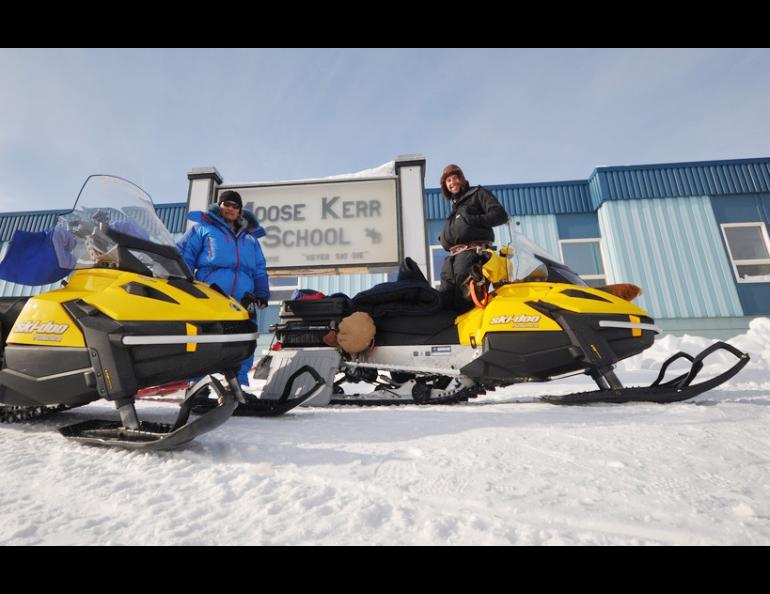

Northwest passage traverses, winter and summer
A few months ago, I wrote about adventurer/permafrost scientist Kenji Yoshikawa’s attempt to drive a snowmachine 3,500 miles from Prudhoe Bay to the Atlantic Ocean. He planned to stop along the way to visit students in 13 villages. Near their schools, he wanted to drill holes in the ground and see how cold it is.
In late April, after 43 days of travel, he and Ulli Neumann quietly executed that endeavor. From Deadhorse they bumped, bashed and slid their way to the Baffin Island village of Iqaluit.
In their journey to the Eastern Time Zone, Yoshikawa and Neumann camped just outside villages and sometimes hundreds of miles from the nearest person. Native hunters they met along the way were impressed most by their Alaska-made Arctic Oven tent, their plastic Siglin Sleds named after the Fairbanks adventurer who invented them and compact 15-gallon fuel tanks that nested in those sleds.
The adventurers needed those gas cans because their trip took them to places with no trails scratched in the wind-hardened snow. While the Yukon Quest sled dog race is impressive for its 201-mile distance between its most far-flung checkpoints, one gap between villages Yoshikawa visited in Canada’s arctic was more than 700 miles. The only evidence of humanity in some places was the occasional airplane arcing above.
Yoshikawa recognized a recurring plane’s path as the Frankfort to Seattle route. In a lonely stretch between villages, he looked up at that jet every day as a cold wind stung his cheeks.
“Only 10 kilometers above, people (were) drinking coffee and watching movies,” he said.
Along his line drawn over the top of North America, Yoshikawa left behind a dozen boreholes he and local students will monitor to see how permafrost — ground that’s been frozen through the warmth of at least two summers, often thousands of summers — reacts in years to come. He also visited underground storage areas in Tuktoyaktuk and other villages. He has now climbed into most of the ice cellars on the cold rim of North America.
As for the two Ski-Doo Tundras that carried Yoshikawa and Neumann to Baffin Island, they are resting in Iqaluit over the summer. Next fall, Yoshikawa hopes to get them shipped to Siberia, where he begins in September as a Fulbright Scholar at North East Federal University in Yakutsk.
In other Northwest Passage news, four Vancouver, British Columbia-based men are now attempting to row a 25-foot white pod through the Northwest Passage from west to east. I met two of them, Kevin Vallely and Frank Wolf, a decade ago as they mountain-biked over ice and snow from Dawson City to Nome with my friend Andy Sterns. Wolf was strong enough to peddle and push through soft snow all day and still document the trip on video.
Wolf and Vallely enlisted two other friends, Paul Gleeson and Denis Barnett, on a journey during which they row four hours at a shift. Using their arms, torsos and legs, they keep the boat moving through all 24 hours of daylight when the winds allow. They hope to reach Pond Inlet, Nunavut, on the east coast of Baffin Island, by September 1.
Why? Because adventure and new challenges make them happy. They also want to bring attention to recent warming in the North. Their premise is that even icebreakers with million-gallon diesel tanks have failed to make it through the passage over North America, but ice has become spotty enough that a team of four guys using their muscles can perhaps make it through.
As of this writing, the boys were battling winds while headed on a crooked track northeastward in the Beaufort Sea, hugging the coast. See their progress at http://mainstreamlastfirst.com/. They have a tangible deadline of mid-September, the time when northern sea ice begins to grow again. Then, the passage will become too chunky with ice, even for a boat not much bigger than a beluga.
Since the late 1970s, the University of Alaska Fairbanks’ Geophysical Institute has provided this column free in cooperation with the UAF research community. Ned Rozell is a science writer for the Geophysical Institute.






